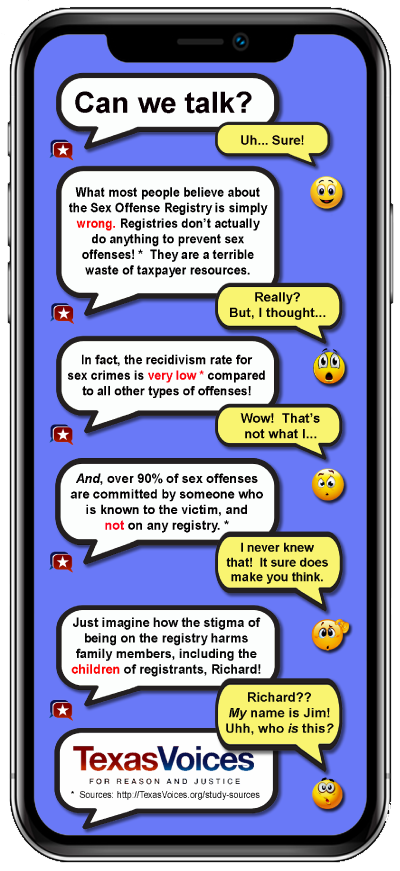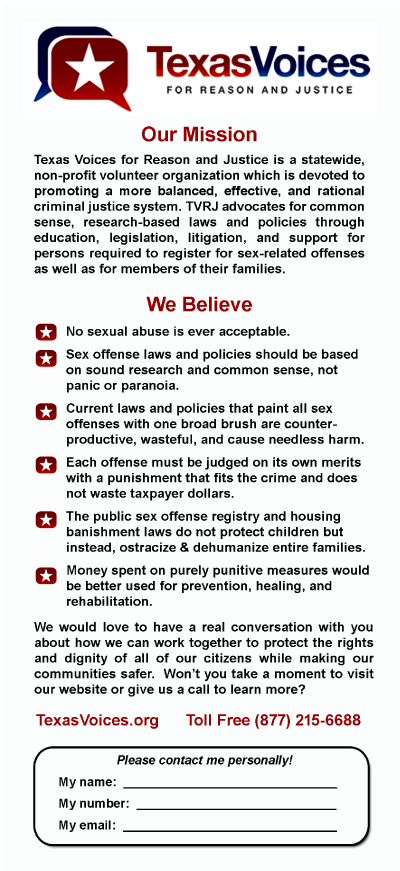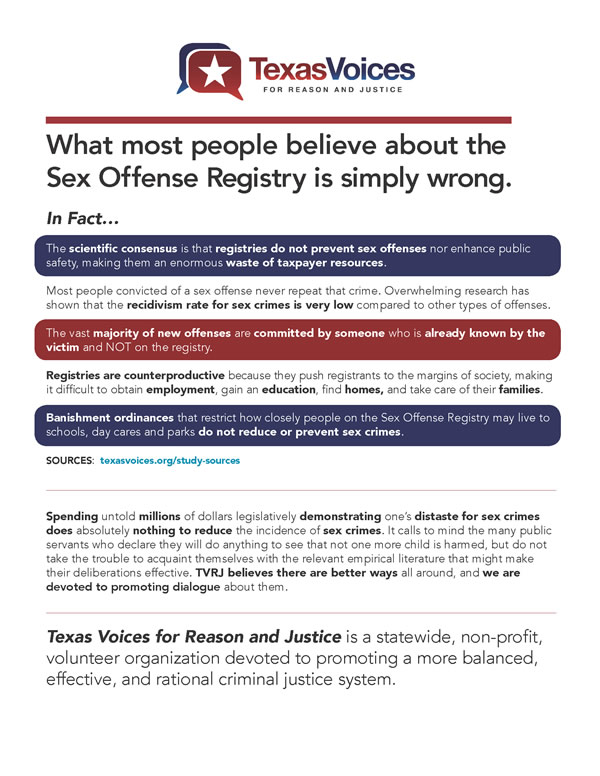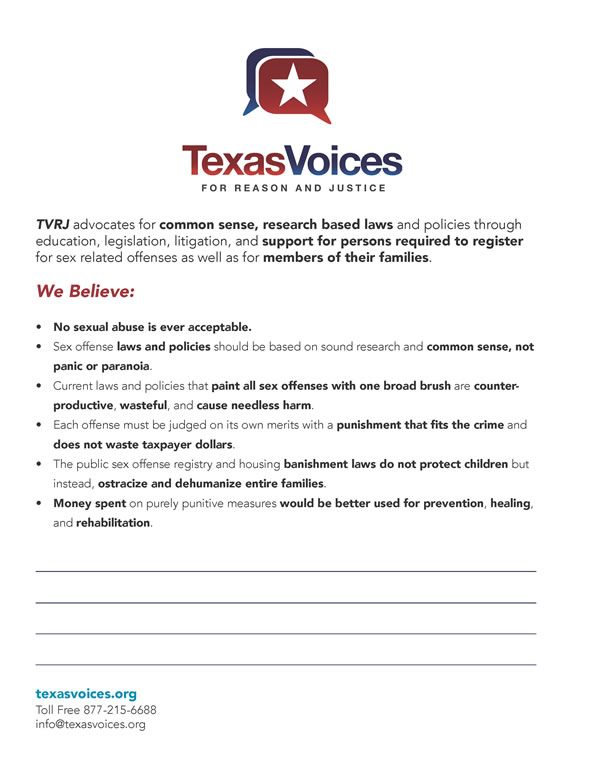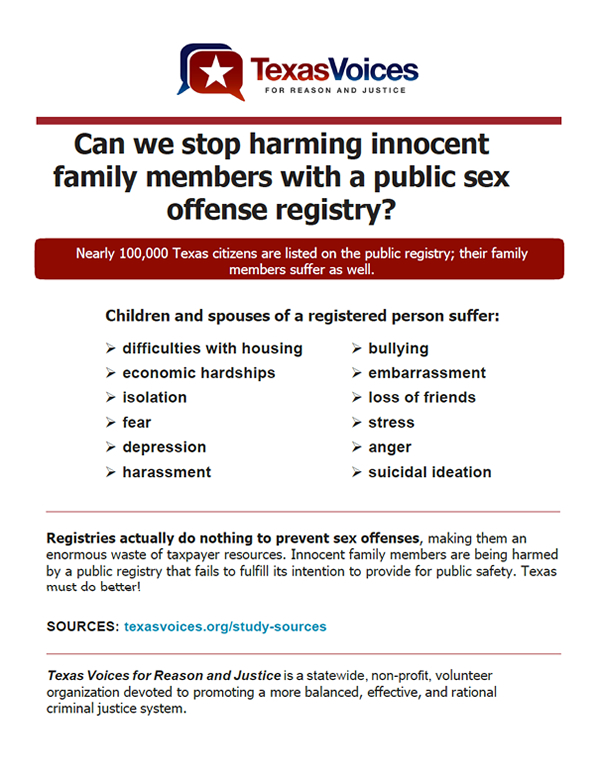Can we talk . . . . ?
Research Sources
RECIDIVISM RATES LOW
(1.) Elam, I.M, and Elam, T. 2015. “FRIGHTENING AND HIGH”: The Supreme Court’s Crucial Mistake About Sex Crime Statistics,” Constitutional Commentary, 30 (1) 495 – 508.
“The label “sex offender” triggers fear, and disgust as well. Both responses breed beliefs that do not yield easily to facts. That’s why even those politicians now urging criminal justice reforms conspicuously omit mentioning sex offenses when they argue for less punitive policies that would facilitate the offenders’ reintegration into civil society. Unfortunately, the Supreme Court has fed the fear. It’s become the “go to” source that courts and politicians rely upon for “facts” about sex offender recidivism rates that aren’t true. Its endorsement has transformed random opinions by self-interested nonexperts into definitive studies offered to justify law and policy, while real studies by real scientists go unnoticed. The Court’s casual approach to the facts of sex offender re-offense rates is far more frightening than the rates themselves, and it’s high time for correction. Perhaps there’s now hope it may soon happen.”
(2.) Langan, P.A., Schmitt, E.L. & Durose, M.R. 2003. “Recidivism of Sex offenders Released from prison in 1994.” U.S. Department of Justice, Office of Justice programs, Bureau of justice Statistics, NCJ 198281
“Of the 9,961 sex offenders released, 3.5% (339 of the 9,961) were reconvicted of a sex crime within the 3-year follow-up period. . . . The overall rearrest rate for the 262,420 released non-sex offenders was higher, 68% (197,391 of 262.420).”
ACQUAINTANCE/FAMILY DANGER (Strangers? Not so much.)
(3.) Tjaden, P. and Thoennes, N. November 1998. “Prevalence, Incidence, and Consequences of Violence Against Women: Findings From the National Violence Against Women Survey,” National Institute of Justice Centers for Disease Control and Prevention, U.S. Department of Justice
“The survey confirms previous reports that U.S. women are primarily raped and/or physically assaulted by intimate partners: 76 percent of the women who were raped and/or physically assaulted since the age of 18 were assaulted by a current or former husband, cohabiting partner, or date; 17 percent were victimized by an acquaintance, such as a friend, neighbor, or coworker; 14 percent were victimized by a stranger; and 9 percent were victimized by a relative other than a husband.”
(4.) Fortney, T. Levenso, J.,Brannon,Y., & Baker, J.N. 2007. “Myths and Facts about Sexual Offenders: Implications for Treatment and Public Policy,” Sexual Offender Treatment, 2 (1).
“Though most contemporary sex offender policies have been inspired by random acts of sexual violence against children, researchers have established that individuals known to the victim commit the vast majority of sex offenses (Bureau of Justice Statistics, 1997; 2000). The Department of Justice reported that 34% of sexually abused minors were assaulted by relatives and 59% of their perpetrators were acquaintances (Bureau of Justice Statistics, 2000). About 49% of victims under the age of 6 are abused by family members and only 7% of sex crimes against minors are perpetrated by strangers (Bureau of Justice Statistics, 2000).”
REGISTRY USELESS AND EXPENSIVE
(5.) J.C.Sandler, J.C, Freeman, N. J. and Socia K.M. 2008. “ DOES A WATCHED POT BOIL? A Time-Series Analysis of New York State’s Sex Offender Registration and Notification Law.” Psychology, Public Policy, and Law, 14, (4) 284–302.
“Despite the fact that the federal and many state governments have enacted Registration and community notification laws as a means to better protect communities from sexual offending, limited empirical research has been conducted to examine the impact of such legislation on public safety. Therefore, utilizing time-series analyses, this study examined differences in sexual offense arrest rates before and after the enactment of New York State’s Sex Offender Registration Act. Results provide no support for the effectiveness of registration and community notification laws in reducing sexual offending by: (a) rapists, (b) child molesters, (c) sexual recidivists, or (d) first-time sex offenders. Analyses also showed that over 95% of all sexual offense arrests were committed by first-time sex offenders, casting doubt on the ability of laws that target repeat offenders to meaningfully reduce sexual offending.”
(6.) Zgoba, K., Witt, P., Dalessandro, M., & Veysey, B. 2008. “Megan’s Law: Assessing the Practical and Monetary Efficacy.” The Research & Evaluation Unit Office of Policy and Planning New Jersey Department of Corrections, Trenton, NJ Grant Award # 2006-IJ-CX-0018 National Institute of Justice.
“The following points highlight the major findings of the three phases of the study:
- Megan’s Law showed no demonstrable effect in reducing sexual re-offenses.
- Megan’s Law has no effect on the type of sexual re-offense or first time sexual
- Megan’s Law has no effect on reducing the number of victims involved in sexual
- Costs associated with the initial implementation as well as ongoing expenditures continue to grow over time. Start up costs totaled $555,565 and current costs (in 2007) totaled approximately 3.9 million dollars for the responding counties.
- Given the lack of demonstrated effect of Megan’s Law on sexual offenses, the growing costs may not be justifiable.“
BANISHMENT PROTECTS NO ONE
(7.) Duwe, D., Donnay, W., & Tewksbury, R. 2008. “Does Residential Proximity Matter? A Geographic Analysis of Sex offense Recidivism.” Criminal Justice and Behavior, 35 (4) 484-504.
“Examining the potential deterrent effects of a residency restrictions law in Minnesota, this study analyzed the offense patterns of every sex offender released from Minnesota correctional facilities between 1990 and 2002 who was reincarcerated for a new sex offense prior to 2006. Given that not one of the 224 sex offenses would have likely been prevented by residency restrictions, the findings from this study provide little support for the notion that such restrictions would significantly reduce sexual recidivism.”
(8.) Zandergen, P.A., Levenson, J.S, & Hart T. C. 2007. “Residential Proximity to Schools and Daycares: An Empirical Analysis of Sex offense Recidivism.” Criminal Justice and Behavior. 20 (10) 482.
“There was no significant relationship between reoffending and proximity to schools or daycares. . . . These data do not support the widespread enactment of residential restrictions for sexual offenders.”
REGISTRY STIGMATIZES WHOLE FAMILIES
(9.) Levenson, J. & Tewksbury, R. 2009. “Collateral Damage: Family Members of Registered Sex Offenders.” American Journal of Criminal Justice, 34:54–68
“Family members living with an RSO were more likely to experience threats and harassment by neighbors. Children of RSOs reportedly experienced adverse consequences including stigmatization and differential treatment by teachers and classmates. More than half had experienced ridicule, teasing, depression, anxiety, fear, or anger. Unintended consequences can impact family members’ ability to support RSOs in their efforts to avoid recidivism and successfully reintegrate.”
(10.) Bailey, D.J.S. & Klein,J.L. 2018. Ashamed and Alone: Comparing Offender and Family Member Experiences With the Sex Offender Registry.” Criminal Justice Review 43(4) 440-457.
“We found that the degree of social isolation and shame does significantly differ between registered sex offenders and their family members, with registered sex offenders reporting higher levels of both social isolation and shame compared to family members at the bivariate level. Using ordinary least squares regression analysis, we determined that attitudinal variables (disrespect and unfair sanctions) were the most salient predictors of participants’ perceived intensity of social isolation and shame.”
DRACONIAN LAWS HARM SOCIETY WITHOUT PROTECTING ANYONE
(11.) Ragusa-Salerno, L. M. and Zgoba, K.M. 2012. “Taking stock of 20 years of sex offender laws and research: an examination of whether sex offender legislation has helped or hindered our efforts.” Journal of Crime and Justice, 35 (3) 335–355.
“The present study adds to the existing empirical literature on sex offending by examining the effectiveness of a variety of sexual offender laws passed between the two decades of 1990 and 2010. This study used a sample of 1129 sexual offenders released from New Jersey state correctional facilities during these two decades of legislative focus. Specific attention is paid to the four common themes of the legislation, including sexual offender registration and notification, civil commitment, residence restrictions, and risk designation. When each law is analyzed using its specific purpose and application process, and then compared to a sample of sex offense cases, it becomes apparent that the laws do not apply to a wide percentage of sex offense cases. The researchers conclude that the laws have little preventive capability. The mplications of this finding are discussed.”
(12.) Ackerman, A.R., Sacks, M., and Greenberg, D.F. 2012. “ Legislation Targeting Sex Offenders: Are Recent Policies Effective in Reducing Rape?” Justice Quarterly, 29 (6).)
“This paper uses panel data for the American states for the years 1970–2002 to assess the impact of these policies on the rate at which rapes occur. Our research finds no evidence that our current policies reduce the incidence of rape.”

